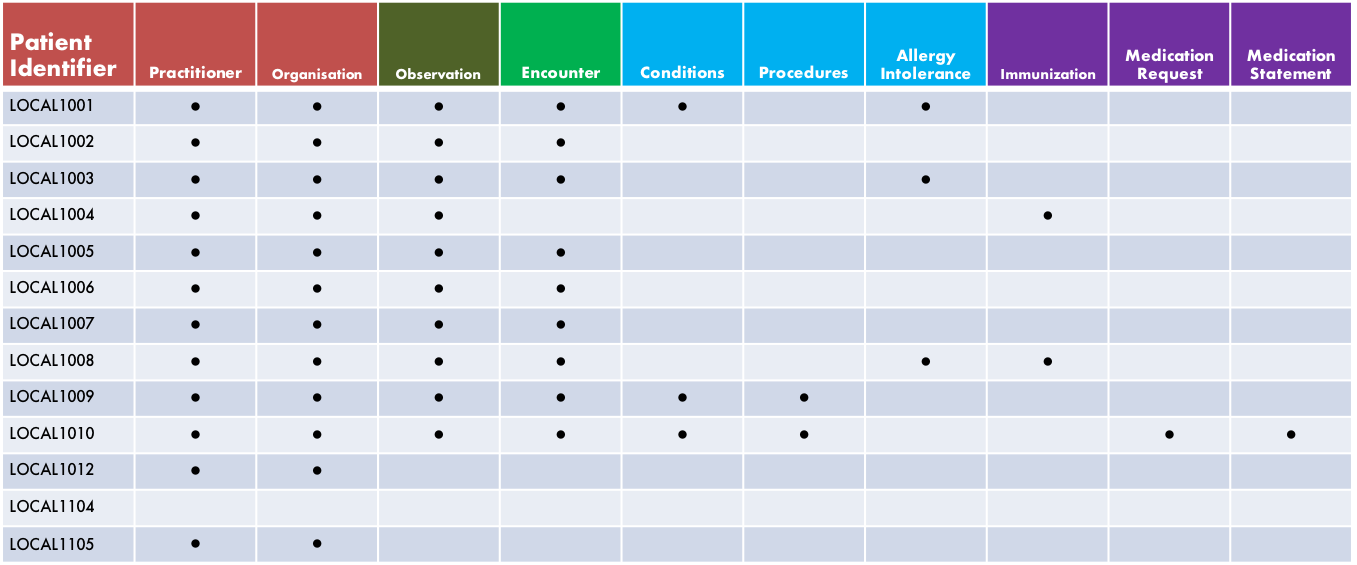How to use the Reference Implementation
The Reference Implementation has been created based on clinically meaningful data.
Mandatory links between resources
As such the mandatory links between the resources has been considered while constructing the data that supports the Ref Impl. This is shown in the diagram below.
Data links between resources in the RI
To extend the mandatory use to provide testable (by developers) and clinically sensible information the following diagram shows the linkage of the data contained within the Reference Implementation.
These links do not define scenarios by themselves. As such the Reference Implementation design has tried to consider a acute care setting. The data contained and linkages have not been clinically verified. To aid in using the logic contained within the data the following short description shows how to use the Reference Implementation to:
- find data,
- find connections between resources contained within the data, and
- to explore national datasets within FHIR.
Sample linked data - Patient Identifiers
The table below shows a sample list of Patient identifiers which you can use to explore some of the data links contained within the Reference Implementation

Demonstration of using the Reference Implementation
The diagram below provides a suggested approach to explore the Reference Implementation CareConnect FHIR profiles and data contained provided with the Reference Implementation.

- To begin with there is a web front end to initially explore the profiles and the data contained.
- Using tools such as POSTMAN allow more control of accessing APIs
The following example shows:
- Patient Search on a name (Name=”Smith”)
- Encounter Id Request (Id=4)
- Condition Id Request (Id=4)
To explore the CareConnect profiles using the web user interface CareConnect Reference Implementation provides a simple way to access the profile searches and can be shown simply and quickly to many audiences. As development progresses switching to a tool like POSTMAN can help with more detailed request and respone API inspection. In the examples below both mechanisms are demonstrated to request information from the CareConnect Reference Implementation:
- Client - Code Java using HAPI libraries
- Request - A GET http request
1. Patient Search
To explore the CareConnect Patient search options use CareConnect Reference Implementation
2. Encounter Id Request
Following the logic of the data contained within the Reference Implementation the following example shows how POSTMAN can be used to request an encounter. API development environments like Postman allow finer control and inspection of the responses from the API. As such the diagram below shows the same patient search within Postman.
3. Condition Id Request
Using POSTMAN we can easily alter the search to another resource such as Condition.
Current Version
Functionality: Provide latest STU3 Care Connect profiles with example data for one care setting with audit of use and accessible by unsecure API interaction and also connect securely via OAuth2 (including an example of using scopes)
Delivered: 26th March 2019
Link: Reference Implementation - web interface
Check out Versions for more information about the current released version, downloading options, use and future verions.
Contribute
This site is structured around Care Connect stakeholders including API users, developers and architects. Please get involved in the journey.
<?xml version=”1.0” encoding=”UTF-8”?>
 INTEROPen
INTEROPen